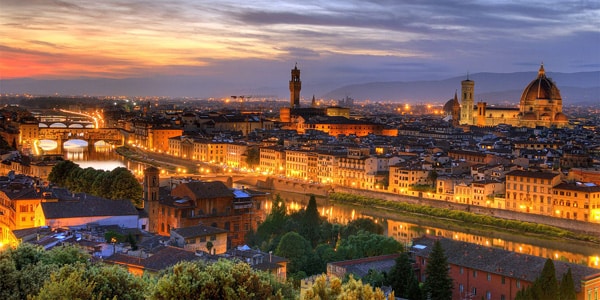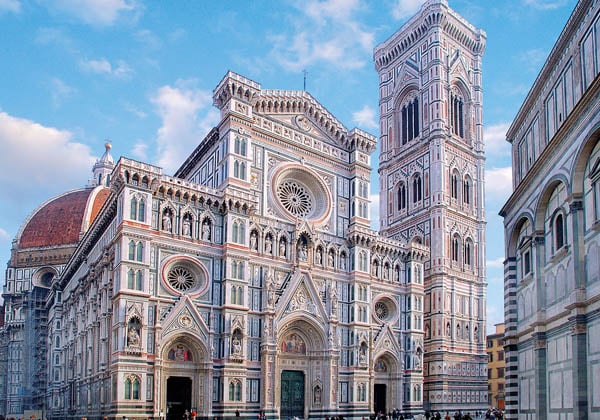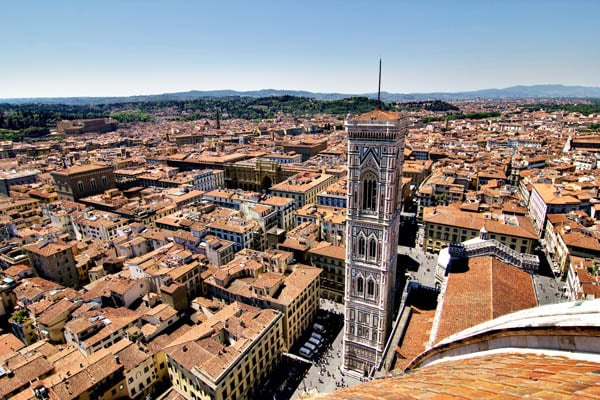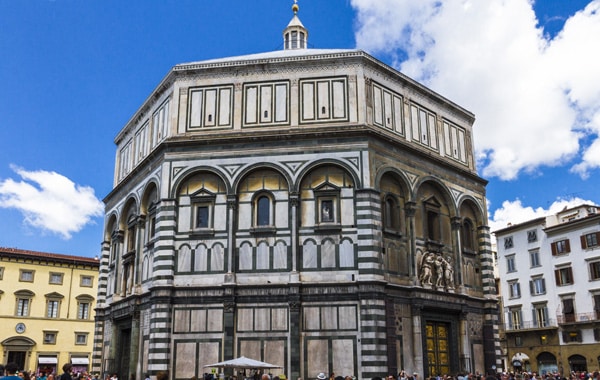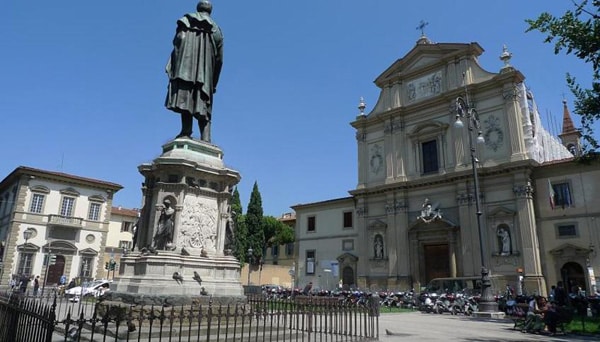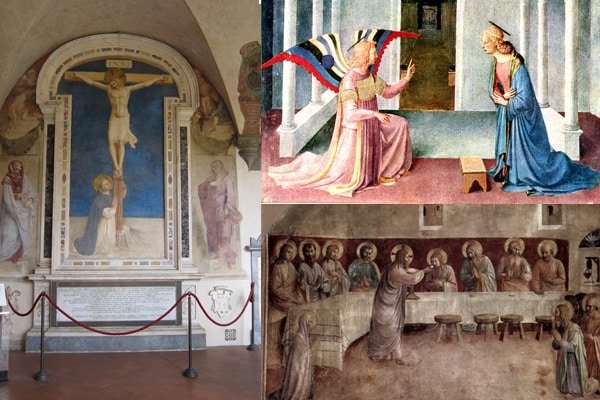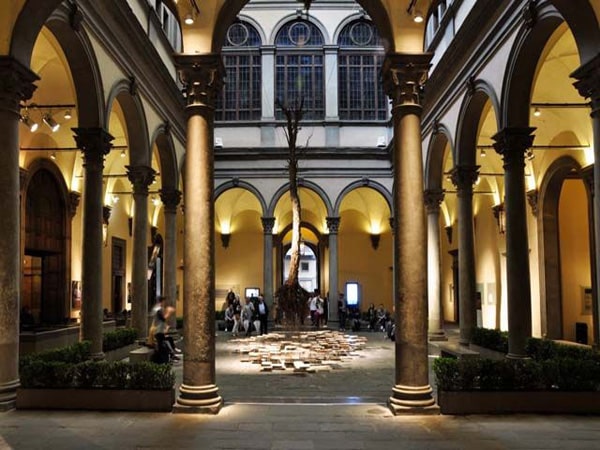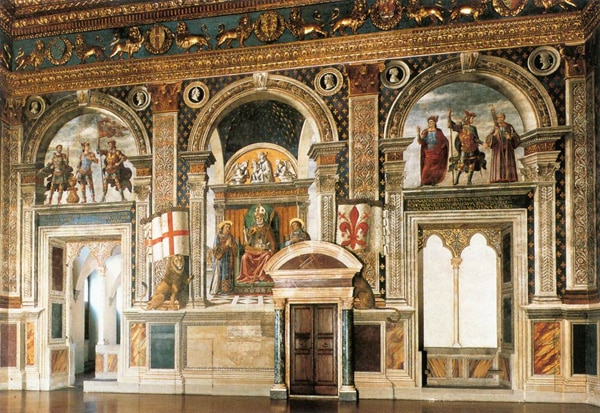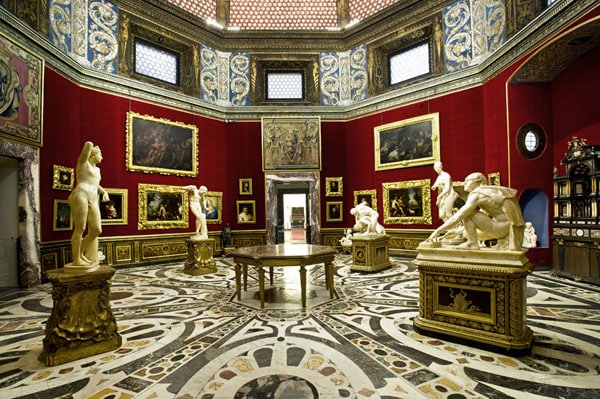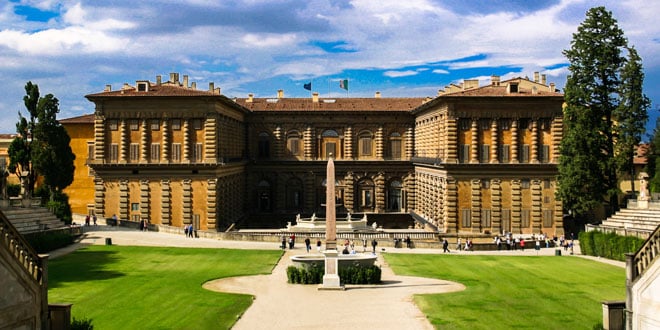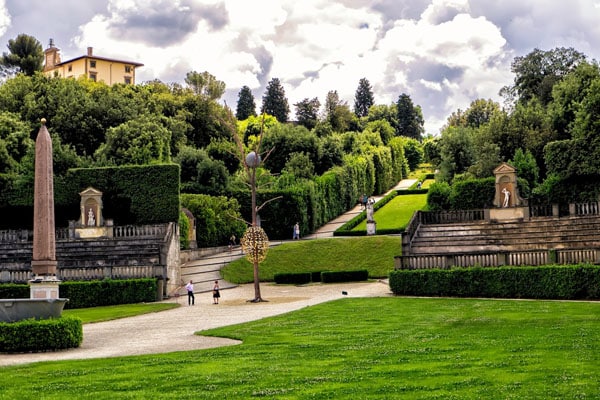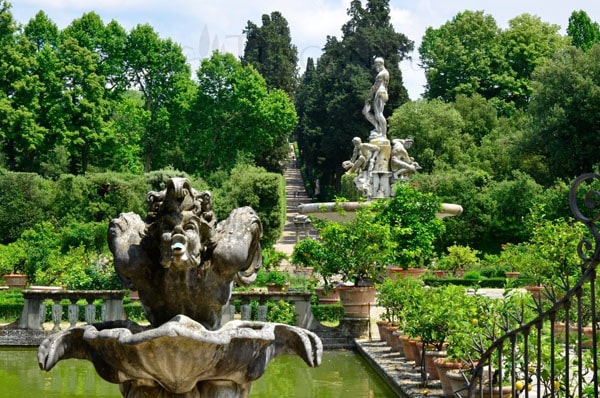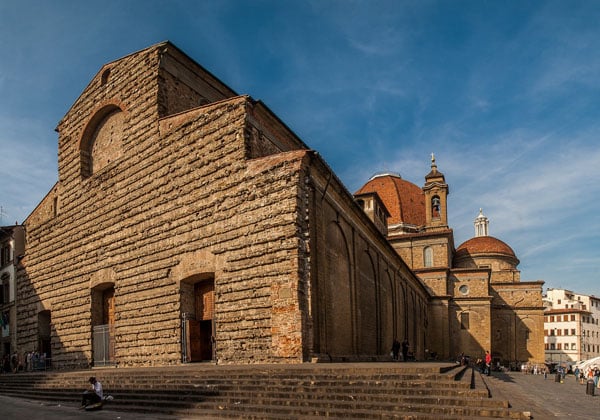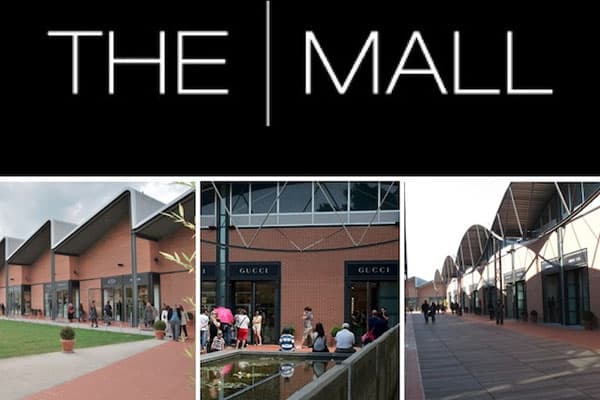Florence is incomparable in terms of beautiful views and historical sights. However, most of the curiosities of the city will require a day, or even more than one, to fully explore it. A city founded in the 1st century BC. is full of majestic cathedrals, luxurious villas and palazzos, green gardens, and other amazing places.
Our guide to attractions with names and detailed descriptions will help you to get the maximum out of this city.
If you are in Florence for the first time:
- We recommend taking at least one private tour to orient yourself in the city and spend your vacation as efficiently as possible.
Page Contents
Cathedral Square – main Florence sight
Cathedral Square (Piazza del Duomo) is a square in the city’s historic center, on which the building of the Cathedral of Florence rises solemnly, surrounded by a bell tower and a baptistery. For a long time, this place has caused exclamations of admiration and the purest spiritual vibes among tourists. From here, it is worth laying the route of your walk in Florence.
The Cathedral of Santa Maria del Fiore
The Cathedral of Santa Maria del Fiore (La Cattedrale di Santa Maria del Fiore) is listed as number one in the “Top attractions in Florence” section of any tourist guide to the city. The temple of impressive size is located in the center of the old town on Collective Square. From a distance, the building stands out with a high, about 90 m, terracotta dome. Filippo Brunelleschi created this masterpiece.
The Duomo was built following the canons of the Gothic. The carved facing of the temple, made of light-colored marble, creates a unique impression. The construction of the cathedral lasted for 140 years, from 1296 to 1436. During this time, the architectural appearance of the building was in charge of recognized masters: Arnolfo di Cambio and Giotto di Bondone.
The huge cathedral can accommodate 30,000 parishioners. The interior decoration impresses with its graceful beauty, transferring the visitor to the time of the Renaissance. The high vaulted nave of the Duomo leads to the painted dome, where the Last Judgment painting by Giorgio Vasari is depicted. Stained-glass windows, sculptures, paintings, and crypts add solemnity to the interior decoration.
Giotto’s Bell Tower
Giotto’s Bell Tower (Campanile di Giotto), which is also a campanile, complements the undeniable beauty of the Duomo. The slender silhouette of the bell tower is a duet to the dome of the Cathedral of Santa Maria del Fiore. The height of the tower is 85 meters. It is lined with multi-colored marble slabs from its foundation to the top. High elongated windows and external decor are the embodiment of Gothic with a touch of the Italian proto-Renaissance of the XIV century.
The author of the campanile is the unforgettable Giotto, but most of the construction and finishing work was supervised by Andrea Pisano. The bell tower impresses with its multifaceted decoration – masterfully executed bas-reliefs, carved medallions by Giotto, and sculptures by Donatello. A special mention is worth a breathtaking view of the city, which opens from the height of an ancient tower.
Read also about Best Rooftops and Viewpoints in Florence.
The Baptistry of San Giovanni
The Baptistery of San Giovanni (Battistero di San Giovanni) is the third element in the architectural complex of the Duomo of Florence. The first baptismal house appeared on this site in the 5th century AD. The modern wide building with an octagonal dome was built in the 12th century. The baptismal’s squat ” keg ” stands at the cathedral’s forefront.
The exterior decoration of the baptistery is in harmony with the decor of other buildings in the cathedral square. Guests of the city enthusiastically consider the original design of the Southern, Northern, and Eastern gates of the building. Bronze engraved paintings of biblical themes decorate the door panels. Inside the baptismal, the most impressive is the painted dome depicting Jesus, the saints, and the Last Judgment.
Piazza San Marco
A small square (Piazza di San Marco) overlooking the facade of the Basilica of San Marco (Basilica di San Marco) and the monastery of the Order of the Sylvesters. Both buildings date back to the XIII century, but in the XV century, they were reconstructed by the architect Michelozzo (Michelozzo di Bartolomeo) for Cosimo I.
Museum of San Marco
The Museum of San Marco (Museo Nazionale di San Marco), located in a building that previously belonged to the church, has a complicated history. For a long time, there was a library within the walls of the former convent of San Marco, which several times passed from the hands of the church to the Medici and back. The building finally became the property of the state in 1866. The church library turned into a national museum in just a few years.
The frescoes painted on the walls and vaults in the XIV-XV centuries are of great value to visitors. Frescoes by Fra Beato Angelico, Ghirlandaio, Fra Bartollommeo are filled with faith and piety. Most of the canvases were also painted by novices of the monastery of San Marco and artists close to religion.
Palazzo Medici Riccardi
The Medici-Riccardi Palace (Palazzo Medici Riccardi) of the 15th century demonstrates the strength and wealth of the Medici family. Located in the center of Florence, the mansion was designed by the family’s favorite architect, Michelozzo. The three-story building of light rusticated stone has a lovely little courtyard decorated with medieval sculpture and lemon trees.
When you enter the building with the first sights, you can feel the superiority of the Medici over other influential houses of the XV century. The glorious ceiling frescoes and paintings are involuntarily breathtaking. The Chapel of the Magi, completely dedicated to biblical paintings, is singled out separately.
Read about Lorenzo the Magnificent and Cosimo Medici.
Palazzo Strozzi
Palazzo Strozzi – the Florentine nobleman Filippo Strozzi mansion – a monumental and expensive building made according to the canons of the early Renaissance. Externally, the building is a laconic three-story palace.
The main beauty lies in the patio as well as the palazzo interiors. Since the beginning of the 20th century, various cultural events and exhibitions have been held in the palace. In addition, the Center for Contemporary Art, located on the second floor of the building, regularly invites foreign exhibitions to the Palazzo Strozzi.
Signoria Square
Signoria Square (Piazza della Signoria), which served as a symbol of power in the days of the Florentine state, makes an impressive impression due to the harsh castle-fortress. Decorated with Renaissance statues: Michelangelo’s famous “David” and Donatello’s “Judith,” it is worth seeing.
Palazzo Vecchio
Palazzo Vecchio – The old palace was built in the 13th century by Arnolfo di Cambio. Since its construction, the building has been used for government needs. The appearance of the palazzo symbolizes impregnability and power. The mansion is crowned with a jagged crown, and a clock tower rises above the roof. At various times, priors, and seniors, lived in the palace, and the Duke of Tuscany Cosimo I (Cosimo I de Medici) lived.
Palazzo Vecchio is interesting because of the contrast between its external and internal design. The elegant patio, made by Michelozzo (Michelozzo di Bartolomeo), is filled with views of European cities of the 15th century.
Grandiose Hall of Five Hundred (Salone dei Cinquecento), dedicated to the military successes of Cosimo Medici impresses the visitors. In other halls, it is worth paying attention to the coffered ceiling and frescoes of Ghirlandaio (Domenico Ghirlandaio) in the Lily Hall, paintings, sculptures, an impressive globe, and a collection of old maps.
The Uffizi Gallery
The Uffizi Gallery (Galleria degli Uffizi) is a 10-minute walk from Piazza della Signoria, and you can easily get there moving towards the Arno River. The medieval palace is filled with the most valuable paintings by Italian, European, and Flemish artists. The Medici were the founders of the art gallery. Thanks to their connections and wealth, they got real masterpieces.
The Uffizi proudly presents to visitors the works of Sandro Botticelli, Leonardo da Vinci, Uccello, Raffaello Santi, Tiziano Vecellio and many others.
Ponte Vecchio Bridge
The Ponte Vecchio Bridge or the Old Bridge is the most respectable crossing over the Arno in the city of Florence. At the same time, it is its main decoration. The bridge was built in the XIV century and has remained almost unchanged. By the way, the river and the Old Bridge that spread over it is the next stop of the walking route in Florence after the Uffizi Gallery.
The bridge is unique for several reasons: first, buildings are located on both sides, right above the water. Secondly, the Vasari Corridor (Corridoio Vasariano) was built over the pedestrian arch in the 16th century, which paved the safe way from the Palazzo Vecchio to the Palazzo Pitti.
Read also about The Most Beautiful & Famous Bridges In Venice.
Palazzo Pitti
Palazzo Pitti is the largest palace that Florence has ever known. It was built in the 15th century by the powerful Medici family.
The residence of the Italian dukes in modern times has become home to several museums: an art gallery, an exhibition of contemporary art, as well as silver, porcelain, carriage manufacturing, fashion, and costume history.
Rusticated palazzo is famous for its Baroque interiors, painted walls, colorful frescoes, surprisingly fine stucco, silk wallpaper, and priceless exhibits of the Renaissance.
Boboli Gardens
Boboli Gardens (Giardino di Boboli) is hidden from the eyes of passers-by by the Pitti Palace. And even though the main attractions of Florence are embodied in stone, do not forget about the beauty of Italian nature. The huge park that covered Boboli Hill was laid out in the 16th century and served as a place for walking the Duke of Tuscan Medici, his family, and guests.
The territory of the park has been expanding with each century, and now it covers an area of 4.5 hectares. Numerous paths cut through the dense vegetation. Statues, fountains, grottoes, columns, and even an imitation of an ancient amphitheater are skillfully intertwined with fragrant plants. Spending time will fill you with unforgettable pleasure and relaxation.
Church of San Lorenzo
The Church of San Lorenzo (Basilica di San Lorenzo) is another Florentine attraction that deserves the prefix “the most.” It’s an early Christian church of the 4th century AD, renovated in the Romanesque style in the 11th century. In the Middle Ages, Brunelleschi reconstructed it significantly. Finally, in the 15th century, the Medici family took patronage over the temple.
The basilica has impressive interior decoration, including a white and gold coffered ceiling, a painted dome, and the work of the best architects of the Renaissance. However, this temple is best known as the resting place of the princes of the Medici family. The last of them is in a coffin in the temple’s New Sacristy (sacristy).
Church of Santa Croce
The Basilica dedicated to the Holy Cross (Basilica di Santa Croce) is located near the historic center of the city. The beginning of the construction of the temple fell in the last decade of the XIII century. There is a legend that the idea of creating this church belonged to St. Francis himself. Unfortunately, the building had been repeatedly destroyed and rebuilt with the money of wealthy Florentines. Therefore, in the appearance of the temple, there is a mixture of Gothic and Proto-Renaissance styles.
The white marble Santa Croce is famous because its decoration is made up of the works of eminent masters: wall paintings and sculptures by Giotto works by Donatello and Antonio Canova (Antonio Canova). The altar of the church also impresses. In addition, Santa Croce occupies a special place due to the extensive pantheon of tombs of prominent city and country residents. About three hundred tombs are under the arches of the temple. Of these, the most significant tombs are Niccolo Machiavelli, Dante Alighieri, Galileo Galilei.
The Mall Luxury Outlet
The Mall outlet is a huge department store turned into a fashion shopping paradise.
Italy is a fashion trendsetter, and one of the undeniable attractions of the fashion world is located in the suburbs of Florence. Outlet buyers get access to sales and incredible discounts on expensive branded goods: clothes, bags, perfumes, cosmetics, shoes, accessories, and much more.
 Italy for me From Italy with love
Italy for me From Italy with love

